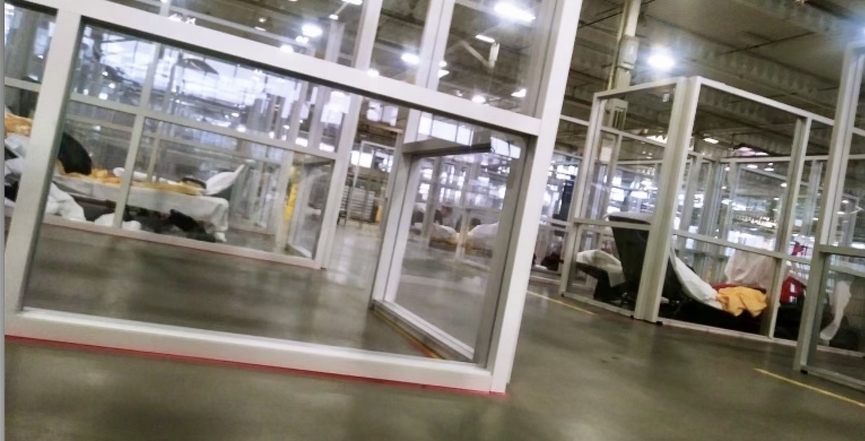Let’s face it. Toronto has a lousy track record of providing safe shelter for homeless people — for decades.
Eighteen years ago, we learned of a dangerous shelter that was being operated in the basement of a social agency. The organization had the blessing of the city and received city funding. Filmmaker Shelley Saywell, who was in the process of filming Street Nurse, asked for permission to film there and, not surprisingly, was denied.
So Dri, a tent city resident, was outfitted with a secret camera in a baseball cap and he entered. The footage he obtained was so alarming that rather than wait for the editing process and for the film’s release, we held a press conference and provided the footage to the media.
The footage showed over 100 men and women sleeping on the floor, bright lights kept on all night to prevent tripping, no windows in a stagnant and airless basement with sounds of coughing (remember the coughing for later in this read, and think COVID).
Most shocking was that four people were sleeping on the floor in the physical space that one person should be in, according to the United Nations shelter recommendations for refugee camps in cold climates (4.5 by 5.5 square metres per person).
All else aside, it was a firetrap.
Dri, wryly remarked that people wouldn’t let dogs be kept in such conditions.
Jack Layton, then a city councillor, showed the powerful footage at a Toronto city council meeting. It led to outrage and a motion that city shelter capacity should not surpass 90 per cent.
The City of Toronto shelter system has never met that target — not once.
Further evidence of the city’s failure is the 32-year-old “Out of the Cold” program that operates in the winter because shelters are full. Run by volunteers, each site is open one night, necessitating a nightly migration of homeless people throughout the city. This year, due to the pandemic, that program has paused.
Then there have been a series of shelter bandaids over the years. Federal armouries (four times), three empty hospitals and an empty nursing student residence have been used for emergency shelter. Of note, an operator for one of the hospital shelters for couples disallowed same-sex couples from sharing a room until advocates stepped in. All were short term solutions and only opened in response to the work of advocates.
The permanency of warming centres, that open when it is minus 15 degrees celsius, are another indicator the shelter system is broken. Since shelters are full, this becomes a type of policy insurance for the city. City officials and politicians can say they opened the centres so there is a place for people to go. Yet, the city has repeatedly been caught not providing blankets, mats or hot food. So they do the bare minimum.
In 2014, women activists protested the shortage of safe shelter for women, and increased levels of violence and sexual assaults led to two women’s drop-in centres beginning overnight operations. Again, this was a major city failure as some of those women, some as old as 80, still have to sleep on mats on the floor or in a chair.
Then, to freshen the disastrous shelter scene, the city created new lingo: the term “respite centre” to describe shelters that are in fact second or third class shelters that do not meet the city’s own shelter standards.
One 24-hour respite centre was caught by the Toronto ombudsman for operating in a cold church (it was between 11 and 14 degrees inside), with no doors on the washrooms, and no showers or cots.
Other respite centres included the three blue and white sprung domes — structures that pre-COVID slept 100 people on cots — and the 2019 Better Living Centre facility that slept 200 people. In each case, undercover footage by activists exposed inhumane conditions and disease risk.
All of this brings me to the city’s latest fail: a re-opening of the Better Living Centre, repurposed to be COVID-safe for more than 100 people.
Why is the site such a failure? The Better Living Centre site features plexiglass cubicles — with no doors and no privacy — shared washrooms and shower trailers outside. Many say the cubicles resemble a futuristic, sci-fi horror, prison-like cell. Others used humour on Craigslist to make fun of the jaw-dropping 360 degree view that comes with its own day bed.
Canadian health officials have been slow to acknowledge that congregate shelters are dangerous and that COVID can be spread when aerosolized.
Homeless people in encampments, who are being coerced by city outreach workers to move to the cubicles, say they won’t go to this respite centre. Who can blame them? In fact, there is tremendous public support to winterize encampments while we push the city for hotels and permanent housing.
I’ll say it again: the only real protection is one person or one couple per room. Hotels and shelters can substitute for the short term, but not forever. When will the social housing builds start?
Cathy Crowe is a street nurse, author and filmmaker who works nationally and locally on health and social justice issues.
Image: Cathy Crowe



